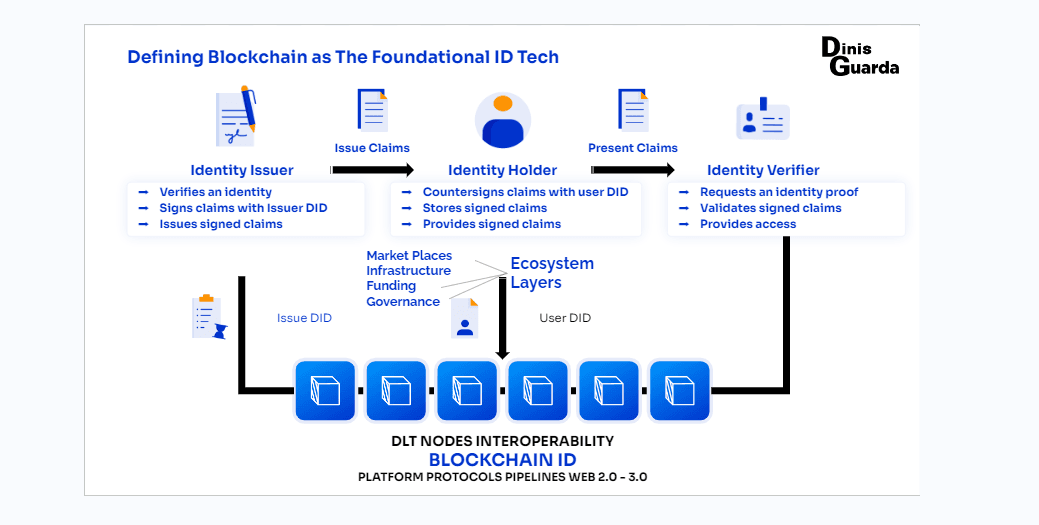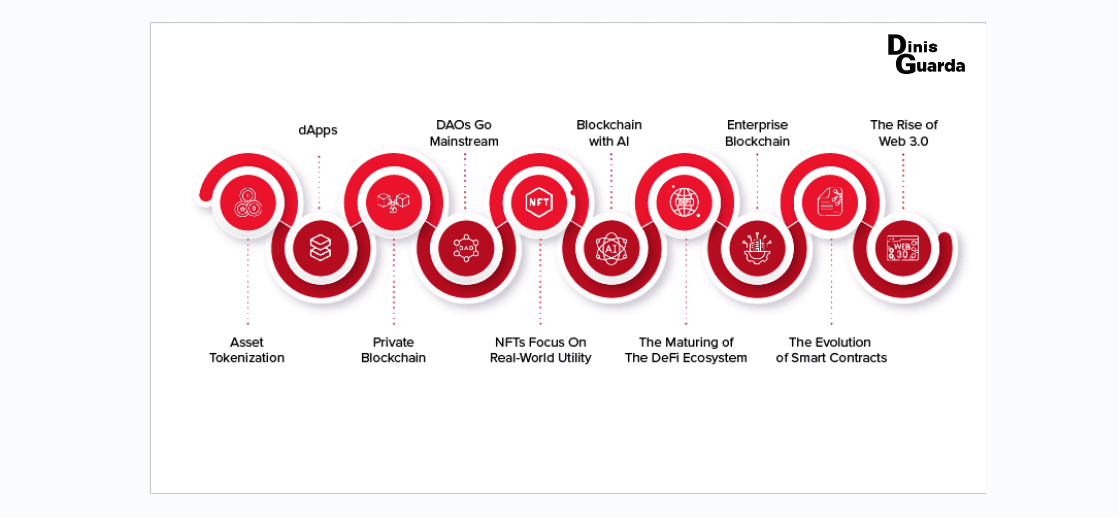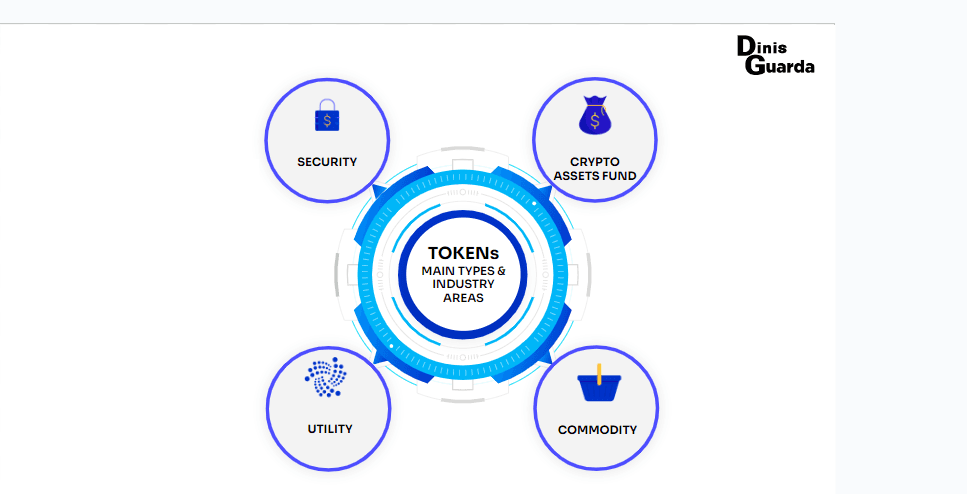open innovation
Global Glossary of Blockchain
27 Feb 2023, 11:56 am GMT
This is a list of top blockchain terms that everyone should know about to learn everything that this technology can offer.
Blockchain is a decentralized and distributed digital ledger that records transactions and tracks assets in a secure and transparent manner. It is composed of a network of nodes that collectively maintain and verify the integrity of the ledger, without the need for a central authority or intermediary.
Each block in the chain contains a cryptographic hash of the previous block, along with a timestamp and a batch of transactions. Once a block is added to the chain, it cannot be altered or deleted, providing an immutable and tamper-proof record of all transactions that have occurred on the network.
Blockchain matters because it enables secure and transparent transactions without the need for intermediaries, reducing the risk of fraud and corruption. It also provides a high level of data privacy and security, as all transactions are encrypted and can only be accessed by authorized parties.
Blockchain technology has a wide range of applications, from financial transactions and supply chain management to healthcare and voting systems. Its decentralized nature also allows for greater inclusivity and accessibility, as it enables individuals and organizations to participate in the network without relying on traditional financial institutions or government agencies.
In short, blockchain has the potential to revolutionize various industries and create new opportunities for innovation and collaboration.

Altcoin
Any cryptocurrency that exists as an alternative to bitcoin
Bitcoin
The first, and most popular, cryptocurrency based off the decentralised ledger of a blockchain
Centralised
Maintained by a central, authoritative location or group.
Chaincode
A program that initialises and manages a ledgers state through submitted applications. It is the Hyperledger Fabric equal to Smart Contracts.
Cryptocurrency
A cryptocurrency (or crypto currency) is a digital asset designed to work as a medium of exchange using cryptography to secure the transactions and to control the creation of additional units of the currency. Cryptocurrencies are classified as a subset of digital currencies and are also classified as a subset of alternative currencies and virtual currencies.
Cryptographic Hash Function
A function that returns a unique fixed-length string. The returned string is unique for every unique input. Used to create a “digital ID” or “digital thumbprint” of an input string.
Cryptography
Cryptography is the practice and study of techniques for secure communication in the presence of third parties called adversaries. More generally, cryptography is about constructing and analysing protocols that prevent third parties or the public from reading private messages; various aspects in information security such as data confidentiality, data integrity, authentication, and non-repudiation are central to modern cryptography.
Decentralised
The concept of a shared network of dispersed computers (or nodes) that can process transactions without a centrally located, third-party intermediary.
Decentralised applications (DApps)
They function like normal apps but instead operate autonomously through the use of smart contracts that run on the blockchain or peer-to-peer (P2P) network of computers.
Decentralised Finance (DeFi)
Peer-to-peer financial services remove intermediaries such as exchanges, brokerages, or banks through the use of smart contracts that run on a blockchain.
Digital Assets Digital representations of various virtual or real-world assets that can be owned and transferred virtually, such as cryptocurrencies and NFTs.
DAO
A decentralised autonomous organisation is an organisation that is run through rules encoded as computer programs called smart contracts.
Digital Asset
Any text or media that is formatted into binary source
Digital Signature
A mathematical scheme used for presenting the authenticity of digital assets
Digital Wallet
A digital wallet (or electronic wallet) is a financial transaction application that runs on mobile devices. It securely stores your payment information and passwords. These applications allow you to pay when you're shopping using your device so that you don't need to carry your cards around. You enter and store your credit card, debit card, or bank account information and can then use your device to pay for purchases.
Distributed ledgers
A distributed ledger is a consensus of replicated, shared, and synchronised digital data geographically spread across multiple sites, countries, or institutions. There is no central administrator or centralised data storage.

Ethereum
Blockchain application that uses a built-in programming language that allows users to build decentralised ledgers modified to their own needs. Smart contracts are used to validate transactions in the ledger.
Exchanges
Digital currency exchanges (DCEs) or bitcoin exchanges are businesses that allow customers to trade digital currencies for other assets, such as conventional fiat money, or different digital currencies. They can be market makers that typically take the bid/ask spreads as transaction commissions for their services or simply charge fees as a matching platform.
Fork
Alters the blockchain data in a public blockchain.
Hard Fork
Alters the blockchain data in a public blockchain. Requires all nodes in a network to upgrade and agree on the new version.
Hyperledger
Started by the Linux Foundation, Hyperledger is an umbrella project of open source blockchains.
ICO
An ICO is an unregulated means by which funds are raised for a new cryptocurrency venture. An Initial Coin Offering (ICO) is used by startups to bypass the rigorous and regulated capital-raising process required by venture capitalists or banks. In an ICO campaign, a percentage of the cryptocurrency is sold to early backers of the project in exchange for legal tender or other cryptocurrencies.
Immutable
“unable to be changed” Data stored in a blockchain is unable to be changed (not even by administrators).
Liquidity
Liquidity describes the degree to which an asset or security can be quickly bought or sold in the market without affecting the asset's price.
Mining
Mining is the process of adding transaction records to Bitcoin's public ledger of past transactions. This ledger of past transactions is called the blockchain as it is a chain of blocks.
Minting
Similar to mining, but uses the Proof of Stake method. Crypto- or NFT owners stake (lock) their assets, after which they may be selected for a transaction validation process, creating new coins.
Node
A copy of the ledger operated by a user on the blockchain.
Non-fungible tokens - NFTs
Non-fungible tokens (NFTs) are assets that have been tokenized via a blockchain. They are assigned unique identification codes and metadata that distinguish them from other tokens.
NFTs can be traded and exchanged for money, cryptocurrencies, or other NFTs—it all depends on the value the market and owners have placed on them.
Cryptocurrencies are tokens as well; however, the key difference is that two cryptocurrencies from the same blockchain are interchangeable—they are fungible. Two NFTs from the same blockchain can look identical, but they are not interchangeable.
On-Chain Data
On-Chain Data refers to transactions made on the blockchain. A transaction is a transfer of value that is broadcast to the network and collected into blocks.
Off-Chain Data
An off-chain transaction is the movement of value outside of the blockchain.
P2P (Peer to Peer)
Denoting or relating to computer networks in which each computer can act as a server for the others, allowing shared access to files and peripherals without the need for a central server.

Private Blockchain
Blockchain that can control who has access to it. Contrary to a public blockchain a Private Blockchain does not use consensus algorithms like POW or POS, instead they use a system known as byzantine fault tolerant(BFT). BFT is not a trustless system which makes a BFT system less secure.
Proof of Activity
Active Stakeholders who maintain a full node are rewarded
Proof of Burn
Miners send coins to an inactive address essentially burning them. The burns are then recorded on the blockchain and the user is rewarded.
Proof of Capacity
Plotting your hard drive (storing solutions on a hard drive before the mining begins). A hard drive with the fastest solution wins the block
Proof of elapsed time
A consensus algorithm in which nodes must wait for a randomly chosen time period and the first node to complete the time period is rewarded
Proof of Stake (POS)
A consensus algorithm that chooses the owner of a new block based on the wealth they have or (Stake). There is not a block reward so the forgers take the transaction fee.
Proof of Work (POW)
A consensus algorithm which requires a user to “mine” or solve a complex mathematical puzzle in order to verify a transaction. “Miners” are rewarded with Cryptocurrencies based on computational power.
Public key cryptography
Encryption that uses two mathematically related keys. A public and private key. It is impossible to derive the private key based on the public key.
Smart contract
Smart contracts are self-executing contracts with the terms of the agreement between buyer and seller being directly written into lines of code. The code and the agreements contained therein exist across a distributed, decentralised blockchain network. Smart contracts permit trusted transactions and agreements to be carried out among disparate, anonymous parties without the need for a central authority, legal system, or external enforcement mechanism. They render transactions traceable, transparent, and irreversible.
Self-Sovereignty
The vision is that individual users should have control over their own information on the internet without having a singular company or government controlling their data, assets, or identity.
Smart Contract
Self-executing contracts exist in and power NFTs on the blockchain network.
Token/Coin
A token makes reference to a unit of value issued by a private entity.?These are digital currencies like Bitcoin in which encryption techniques are used to regulate the generation of units of currency and verify the transfer of funds. They are operating independently of a central bank. Soon every fiat currency may become a cryptocurrency, in that case operating with central banks.
Token Gating
The process involves an individual’s proof of ownership of a specific NFT. This is to provide utility for an NFT collection. Essentially, token gating allows projects to reward people who hold their NFTs by creating exclusive content, events, and other benefits that are available only to token holders.
Share this
Hernaldo Turrillo
Contributor
Hernaldo Turrillo is a writer and author specialised in innovation, AI, DLT, SMEs, trading, investing and new trends in technology and business. He has been working for ztudium group since 2017. He is the editor of openbusinesscouncil.org, tradersdna.com, hedgethink.com, and writes regularly for intelligenthq.com, socialmediacouncil.eu. Hernaldo was born in Spain and finally settled in London, United Kingdom, after a few years of personal growth. Hernaldo finished his Journalism bachelor degree in the University of Seville, Spain, and began working as reporter in the newspaper, Europa Sur, writing about Politics and Society. He also worked as community manager and marketing advisor in Los Barrios, Spain. Innovation, technology, politics and economy are his main interests, with special focus on new trends and ethical projects. He enjoys finding himself getting lost in words, explaining what he understands from the world and helping others. Besides a journalist, he is also a thinker and proactive in digital transformation strategies. Knowledge and ideas have no limits.
previous
What Marketing Strategies Are Being Used In The Gaming Sector In The Last Decade?
next
The Importance of Crash Bollards in Protecting Assets, Pedestrians, and Buildings